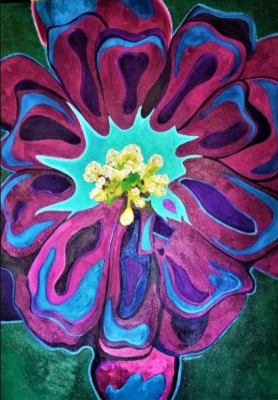St. Augustine’s history is evident in the various architectural styles throughout the city. The gardens referenced here range from small home gardens planted by early residents to landscapes designed by architects. Visit these delightful gardens for a glimpse into the past of America’s Oldest City.
Have you ever wondered about the small gated garden on the corner of Hypolita and St. George Street? In early 1965, Elizabeth Towers, the only female member of the St. Augustine Historical Restoration and Preservation Commission at the time, spearheaded a project to develop the corner lot. She formed the Hispanic Garden Committee, all comprised of women, to bring the Spanish-style garden to life. They coordinated with local garden clubs and organizations to host teas, fashion shows, art auctions, and trinkets donated by the Spanish Pavilion at the 1964 New York World’s Fair to raise funds. About 60% of the project was personally funded by Jessie Ball DuPont from Jacksonville who was inducted to the Florida Women’s Hall of Fame. The only two female landscape architects in Florida at the time, Drusilla P Gjoerloff and Lee W Schmoll were chosen to design the garden.
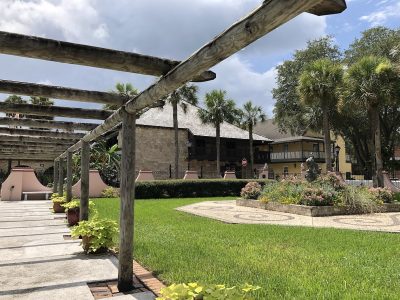
The “plazoleta” is modeled after Spanish gardens (see the Alhambra Palace) which took cues from Roman patios. Flowers fill the ceramic vases and the beds around the perimeter contain marigolds, palm trees, jasmine, cabbage palms, holly, and kumquats. The garden features lots of Spanish influence like an octagonal mosaic and a nod to water features common in Spain during the Moorish occupation. The pool in the center was converted to a planter in 1977.
A sculpture of Queen Isabella of Castile at the center was made and donated by notable artist Anna Hyatt Huntington, who is the first woman to have a public sculpture on display in New York outside of Central Park. That sculpture (Joan of Arc) was NYC’s first monument depicting a woman from history!
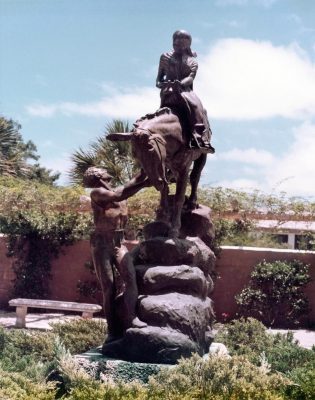
The Hispanic Garden was dedicated to Queen Isabella on September 5, 1965, and completed on the 400th Anniversary dated September 8, 1965. After 2003, concerns of vandalism prompted the city to install a fence around the garden. Today, the garden is closed to the public but is opened by special events like the Easter Week Festival and knighting ceremonies.
In 1889, Henry Morrison Flagler built the Memorial Presbyterian Church and dedicated it to his daughter, Jennie Louise Benedict, who passed earlier that year. The Venetian Renaissance-style building was inspired by St. Mark’s Basilica in Venice, plus several design elements from Spanish, Moorish, Italian, and Baroque styles. This structure has many incredible details including a copper dome made in Italy, mahogany pews, Italian marble floors, and stained glass windows designed by artist Herman T Schaldermundt which took twelve years to complete.
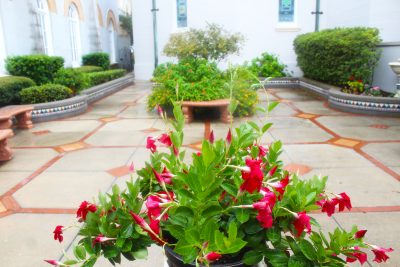
Follow the pathways along the sides of the building to stumble upon a gorgeous garden. In the back, you will find terra-cotta mosaics, intricate tile work, lush shrubbery, and pops of pink from bougainvilleas, hibiscus flowers, hydrangeas, and crape myrtle trees. This little oasis is easily one of the Ancient City’s best kept secrets.
31 St. Francis Street, this national historic landmark is one of the few residences built in the first Spanish Period (1565-1763) that still stands in St. Augustine. In the 1870s, Antonica Llambias and her sister Ana created a beautiful garden complete with a Pride of India tree, orange, guava, and banana trees, and vegetables. In 1893, the Matanzas River and Sanchez Creek flooded the garden in salt water for several days from which it could not be recovered.
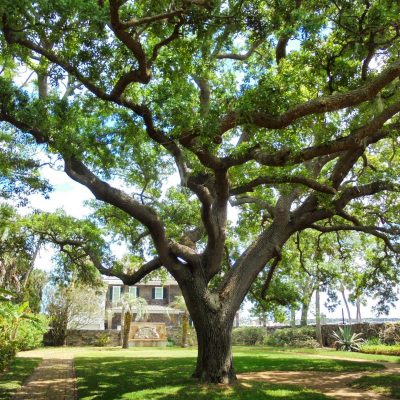
In 1938, the building was purchased as part of a project to preserve and restore St. Augustine by the Carnegie Institution who tasked the Garden Club to maintain it as a garden center. Later, the St. Augustine Historical Society assumed the responsibility and the house was restored. Today, the garden is open for tours and events for a perfect setting among the live oak tree, muscadine grapevines, and herb garden.
The flowers at the St. Augustine Lighthouse have a pretty cool story! During World War II, Grace Daniels, wife of Head Lighthouse Keeper Cardell Daniels, planted yellow lilies. Cardell kept watch between 1935 and 1943. Today, the yellow lilies you see are descendants of ones Grace planted so long ago. Wilma, their youngest daughter, is pictured in front of her mother’s lilies.
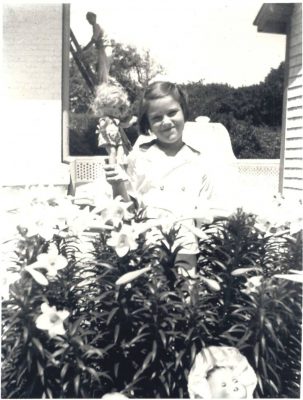
Built around 1750, the Peña-Peck House was home to Spanish and British officials, plus other notable owners and tenants throughout its history. Dr. Seth Peck added the wooden second story to the original coquina structure to create more living space. The house stayed in the Peck family until his granddaughter, Anna Gardner Burt, died in 1931. She left the house, furnishings, antiques, and artwork to the city and was explicit that the house is “maintained as an example of the old antebellum homes of the South.”
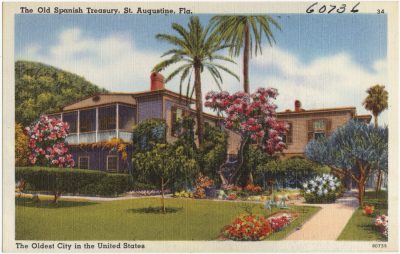
The Woman’s Exchange stepped in to pay annual rent and opened the home for tours on May 1, 1932. They continue to sell handcrafted items and host events in order to support the Peña-Peck House and provide scholarships for women returning to school for new careers. Today, you can see the wonderful garden on St. George Street featuring a canopy of stately oaks and magnolia trees.
The Old Village in downtown St. Augustine, later known as the Dow Museum of Historic Houses, was once known for housing an amazing Rose Museum. In 1955, author and rose historian Jean Gordon rented space from Mr. Kenneth Dow, which he called the Rose House in her honor. The rose is believed to be the oldest of flowers, so she chose St. Augustine, the Nation’s Oldest City, as the site of her museum where she tended to roses and displayed rose motif memorabilia. She wrote several books about roses including “Pageant of the Rose,” “Immortal Roses,” and “The Art of Cooking with Roses.”

Joyce Hutchinson moves deftly through many mediums with subject matter ranging from historical decorative designs to the realism of florals that she creates in oil, acrylic, watercolor, color pencil, and graphite. Her classic education at McKendree University in Illinois anchors her work, but freedom, imagination, and experimentation drive her art. Joyce’s images are diverse but maintain elements of nature to welcome adventure and encourage the discovery of harmony and humanity.
